Poverty and Gender: Determinants of Female- and Male-Headed Households with Children in Poverty in the USA, 2019
Abstract
1. Introduction
2. Background Context
2.1. A Brief Overview of Gendered Work and Wage Gaps
2.2. A Factual Overview of Gender Gaps in Poverty
2.3. Origin of Gender Inequality and Theoretical Conceptualization
3. Research Design
3.1. Study Area and Scale of Analysis
3.2. Data and Methodology
4. Analysis and Findings
4.1. Visual Analysis of Major Variables: Gendered Poverty and Work Status
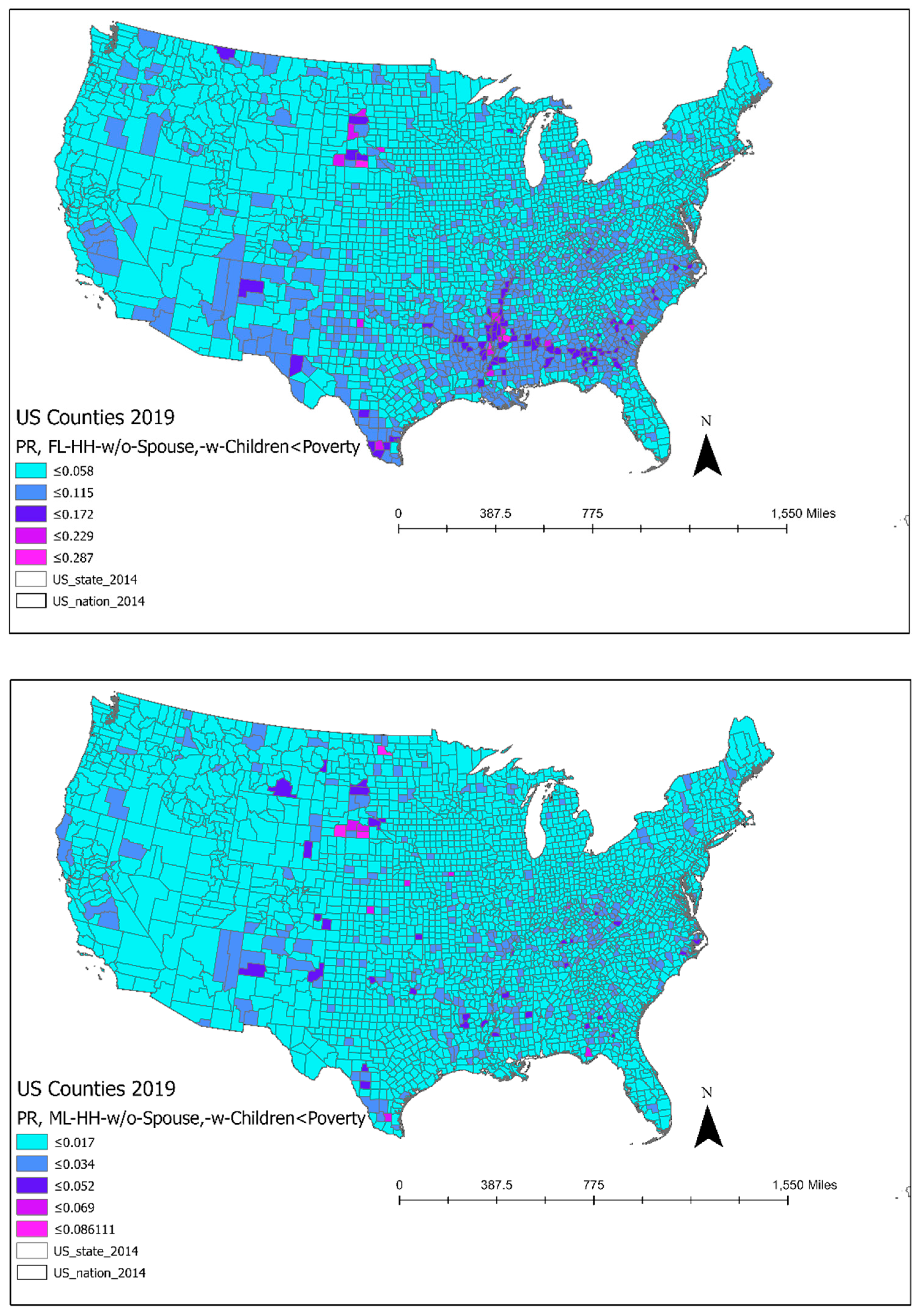
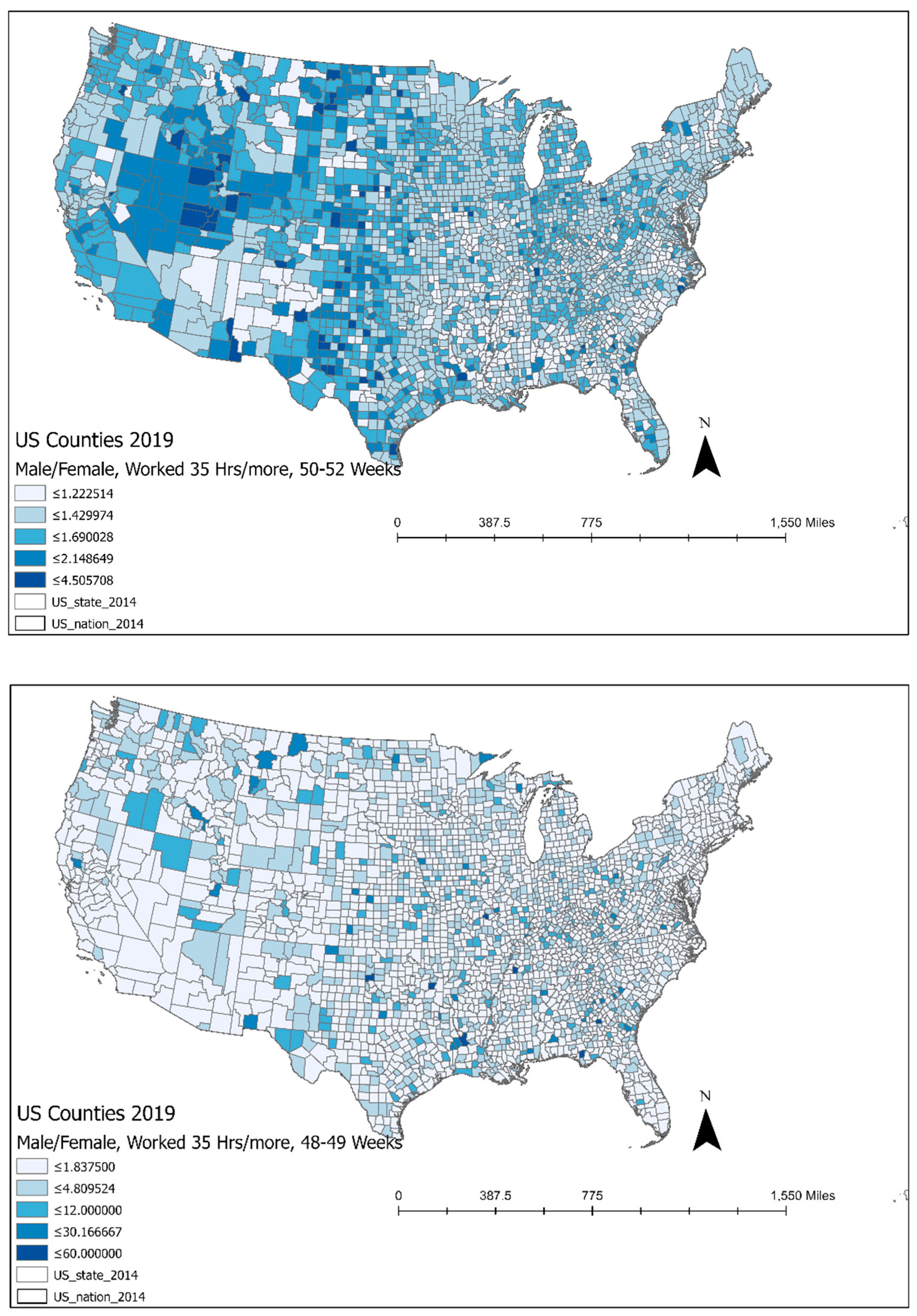
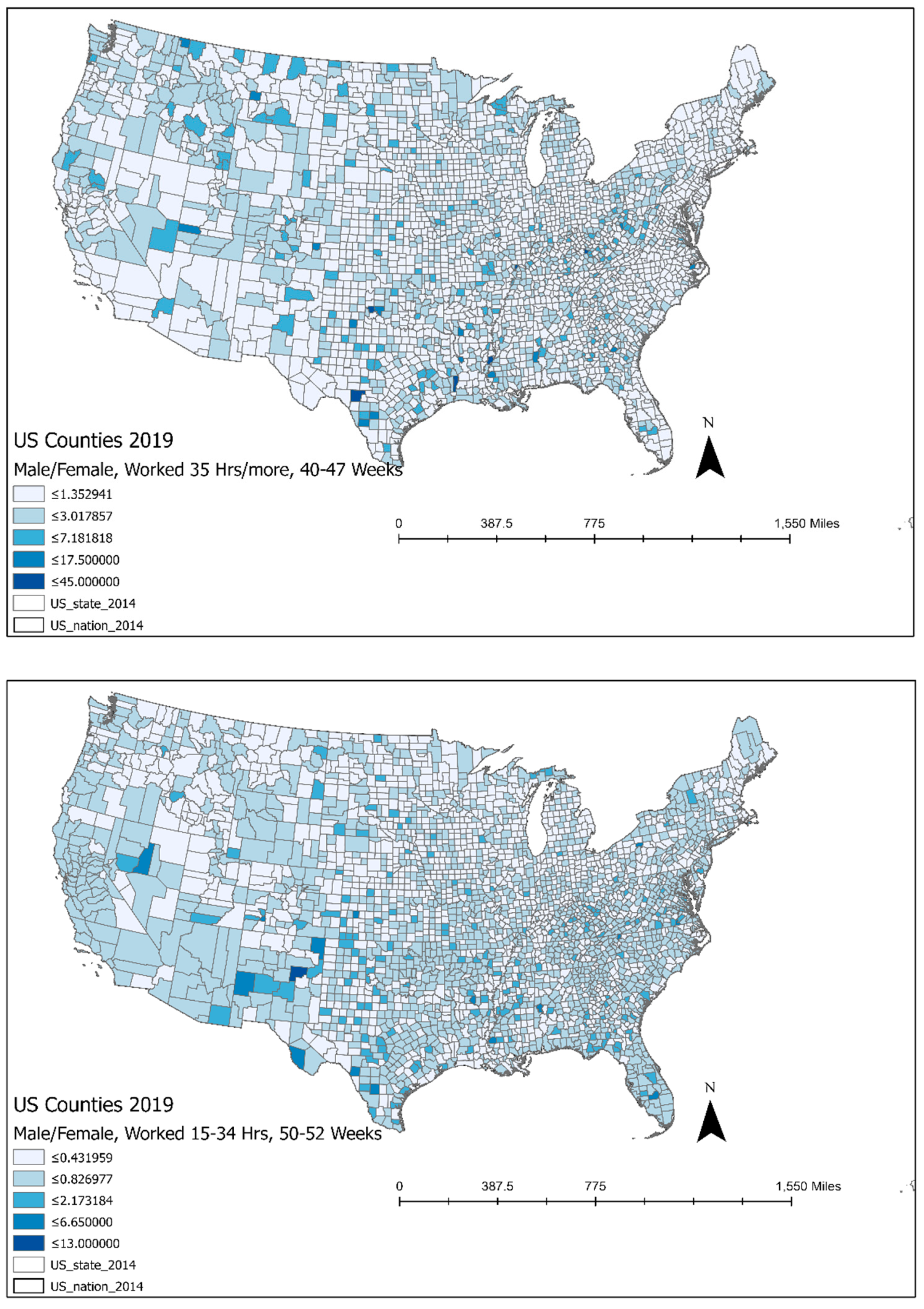
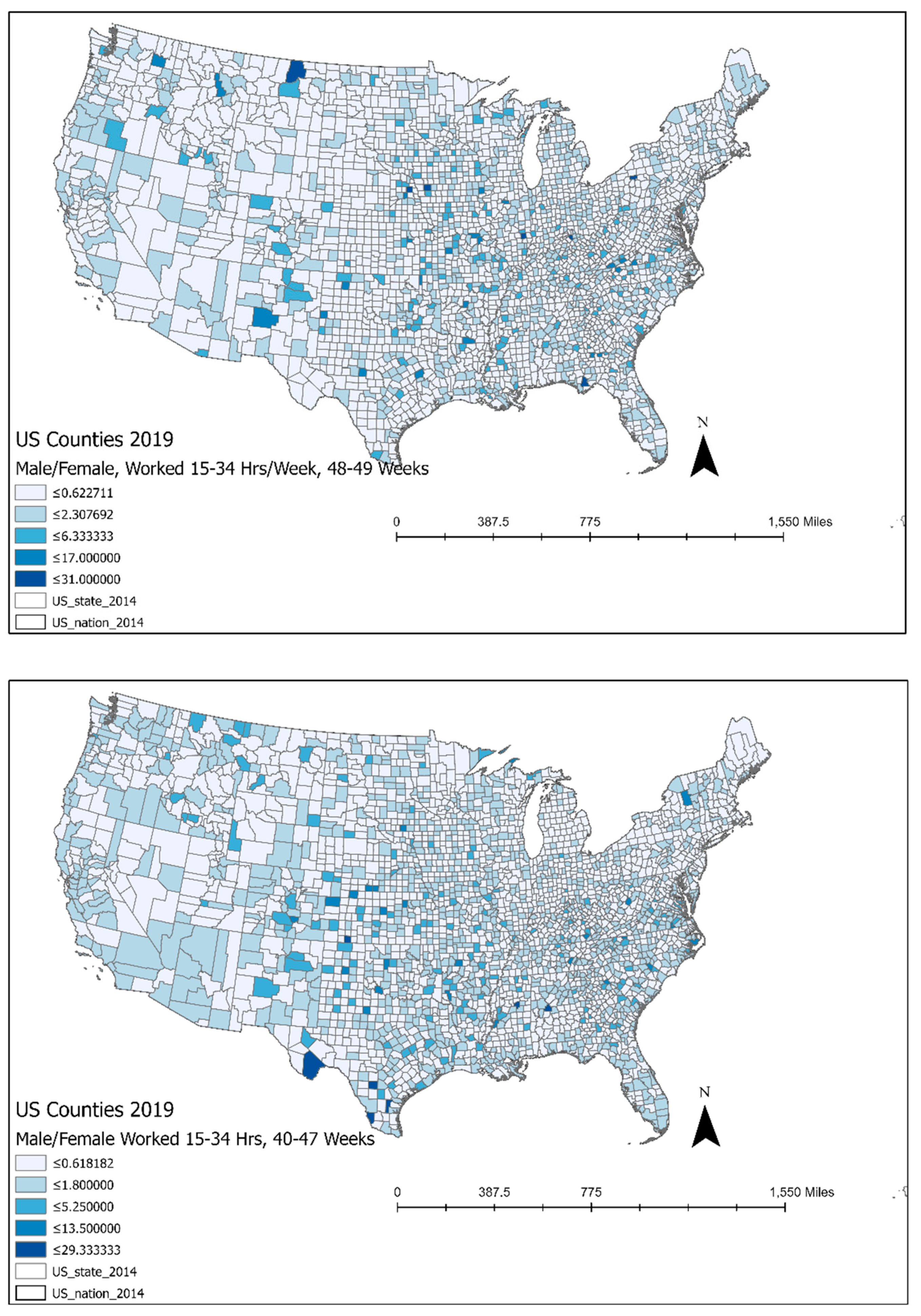
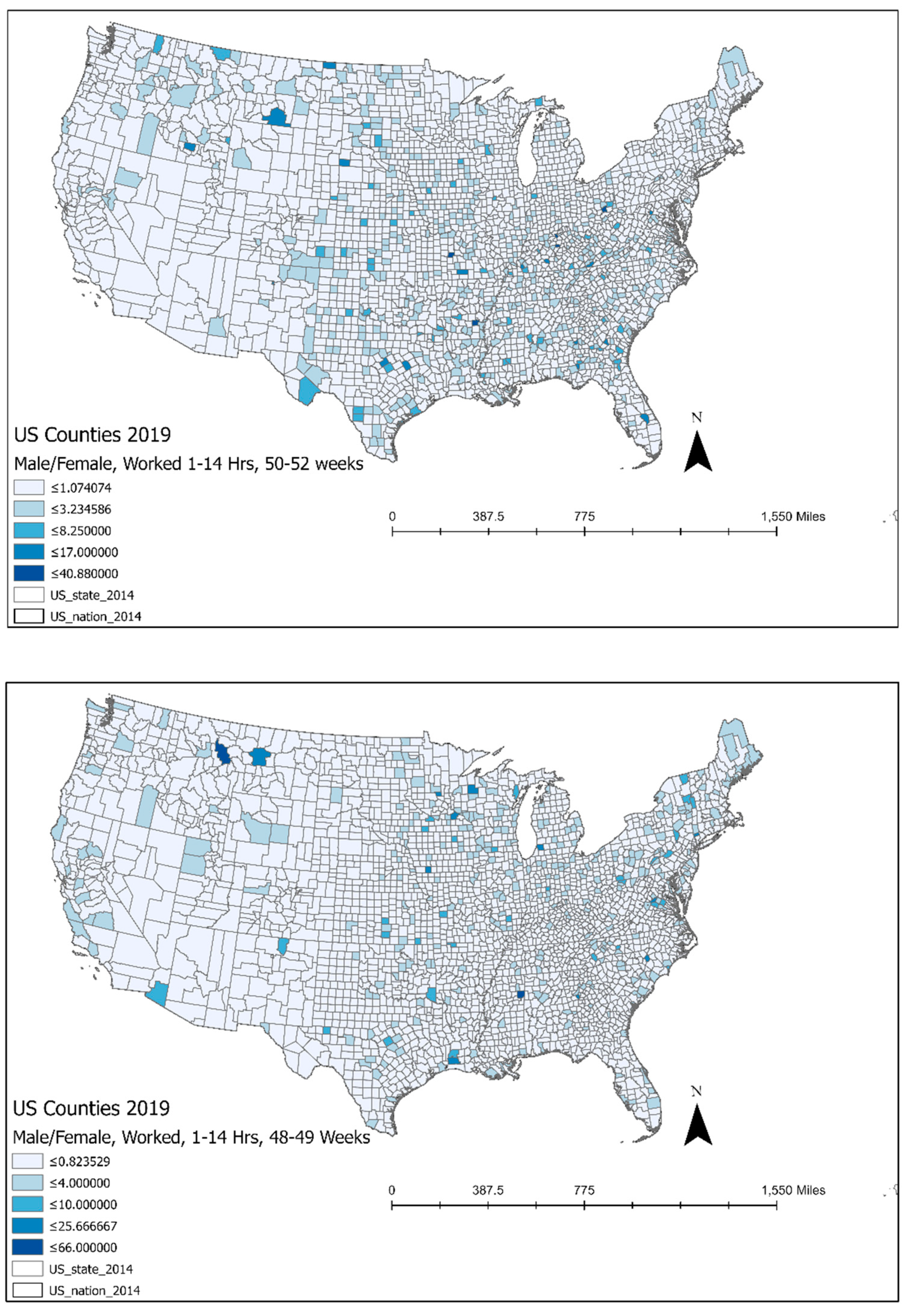
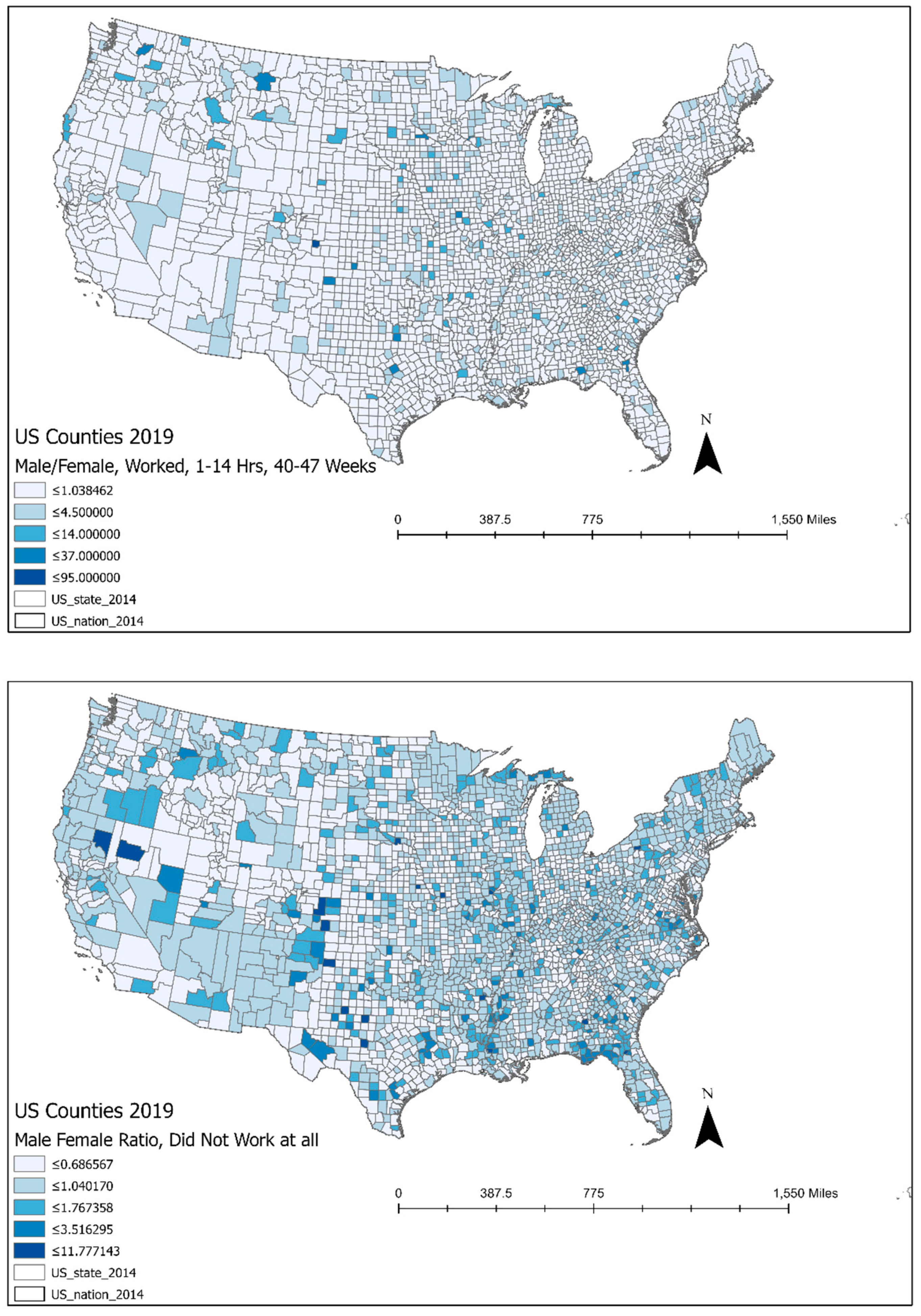
4.2. Educational Attainment across Gender, 2019
4.3. Bivariate Correlations Analysis
4.4. Regressions Models for Female-Headed and Male-Headed Households with Children in Poverty
5. Conclusions and Policy Implications
Funding
Institutional Review Board Statement
Informed Consent Statement
Data Availability Statement
Conflicts of Interest
References
- HTTP1. Gender Equality Will Take 300 Years to Achieve, Says UN Chief, Business Standard, 9 March 2023. Available online: https://www.business-standard.com/article/printer-friendly-version?article_id=123030900003_1 (accessed on 16 March 2023).
- Darden, J.T.; Rahbar, M.; Jezierski, L.; Li, M.; Velie, E. The measurement of neighborhood socioeconomic characteristics and black and white residential segregation in metropolitan Detroit: Implications for the study of social disparities in health. Ann. Assoc. Am. Geogr. 2010, 100, 137–158. [Google Scholar] [CrossRef]
- Essletzbichler, J. The top 1% in U.S. metropolitan areas. Appl. Geogr. 2015, 61, 35–46. [Google Scholar] [CrossRef]
- Kawachi, I. Social capital and community effects on population and individual health. Ann. N. Y. Acad. Sci. 2006, 896, 120–130. [Google Scholar] [CrossRef]
- Glynn, S.J. Gender Wage Inequality: What We Know and How We Can Fix It; Center for Equitable Growth Report; Washington Center for Equitable Growth: Washington, DC, USA, 2018. [Google Scholar]
- Sharma, M. Multiple Dimensions of Gender (Dis)Parity: A County-Scale Analysis of Occupational Attainment in the USA, 2019. Sustainability 2021, 13, 8915. [Google Scholar] [CrossRef]
- Sharma, M. Gender Disparity and Economy in US Counties: Change and Continuity, 2000–2017. In Gender Inequalities: GIS Approaches to Gender; Ozdenerol, E., Ed.; CPC Press: Abingdon, UK, 2020; pp. 73–96. ISBN 9780367184735. Available online: https://www.routledge.com/Gender-Inequalities-GIS-Approaches-to-Gender-Analysis/Ozdenerol/p/book/9780367184735 (accessed on 2 February 2023).
- Sharma, M. Gendered Dimensions of Educational Premium Disadvantage in Earnings in USA, 2019. GeoJournal 2022, 87, 847–868. [Google Scholar] [CrossRef] [PubMed]
- HTTP2: Income and Poverty in the United States: Highlights, 2020. Available online: https://www.census.gov/library/publications/2021/demo/p60-273.html (accessed on 15 March 2023).
- Manson, S.; Schroeder, J.; Van Riper, D.; Kugler, T.; Ruggles, S. IPUMS National Historical Geographic Information System: Version 15.0; IPUMS: Minneapolis, MN, USA, 2020. [Google Scholar] [CrossRef]
- HTTP3. Available online: https://inequality.org/our-inequality-work/ (accessed on 10 March 2023).
- HTTP4. Available online: https://inequality.org/our-inequality-work/reports-2/ (accessed on 9 March 2023).
- Islam, F.B.; Sharma, M. Gendered dimensions of unpaid activities: An empirical insight into rural Bangladesh households. Sustainability 2021, 13, 6670. [Google Scholar] [CrossRef]
- Islam, F.B.; Sharma, M. Socio-economic determinants of women’s livelihood time use in rural Bangladesh. GeoJournal 2022, 87, 439–451. [Google Scholar] [CrossRef]
- HTTP5. U.S. Department of Labor. Available online: https://fortune.com/tag/u-s-department-of-labor/ (accessed on 2 February 2023).
- Gould, E.; Schieder, J.; Geier, K. What is the gender pay gap and is it real? The complete guide to how women are paid less than men and why it can’t be explained away. Econ. Policy Res. Rep. 2016, 20, 1–41. [Google Scholar]
- HTTP6. United Nations News on Gender Equality: International Women’s Day Puts the Spotlight on Digital Gender Equality. Available online: https://news.un.org/en/story/2023/03/1134342 (accessed on 17 March 2023).
- Piketty, T.; Saez, E.; Zucman, G. Replication Data for: ‘Distributional Accounts: Methods and Estimates for the United States’, Harvard Dataverse, 2017. Available online: https://dataverse.harvard.edu/dataset.xhtml?persistentId=doi:10.7910/DVN/SLXCUJ (accessed on 2 February 2023).
- Chari, A.; Goldsmith-Pinkham, P. Gender Representation in Economics across Topics and Time: Evidence from the NBER Summer Institute; Working Paper 23953; National Bureau of Economic Research: Cambridge, MA, USA, 2017; Available online: http://www.nber.org/papers/w23953 (accessed on 18 March 2023).
- Whitmore, D.S.; Ryan, N. The 51%: Driving Growth through Women’s Economic Participation; Brookings Report, 2017. Available online: https://www.hamiltonproject.org/publication/policy-book/the-51-driving-growth-through-womens-economic-participation/ (accessed on 2 February 2023).
- Census 2020 Report, The Bureau of U.S. Census 2020. Income and Poverty Report, 2020; The Bureau of U.S. Census: Suitland-Silver Hill, MD, USA, 2020.
- Coe, N.M.; Kelly, P.F.; Yeung, H.W.C. Economic Geography: A Contemporary Introduction, 3rd ed.; Wiley Blackwell: Hoboken, NJ, USA, 2019; ISBN 978-1-119-38955-2. [Google Scholar]
- International Labour Organization (ILO). More than 60 per Cent of the World’s Employed Population Are in the Informal Economy. 2018. Available online: www.ilo.org/global/about-the-ilo/newsroom/news/WCMS_627189/lang--en/index.htm (accessed on 13 March 2023).
- International Labour Organization (ILO). Women do 4 Times More Unpaid Care Work than Men in Asia and the Pacific, 2018. Available online: https://www.ilo.org/asia/media-centre/news/WCMS_633284/lang--en/index.htm (accessed on 13 March 2023).
- Charmes, J. The Unpaid Care Work and the Labour Market. An Analysis of Time Use Data Based on the Latest World Compilation of Time-Use Surveys; International Labour Office: Geneva, Switzerland, 2019. [Google Scholar]
- WCR. Washington Center Report (2019) on Gender Wage Inequality in the United States: Causes and Solutions to Improve Family Well-being and Economic Growth, (2019); Washington Center for Equitable Growth Report; Washington Center for Equitable Growth: Washington, DC, USA, 2019. [Google Scholar]
- CPS ASEC; U.S. Census Bureau. Current Population Survey 2019 and 2020 Annual Social and Economic Supplements (CPS ASEC); U.S. Census Bureau: Suitland-Silver Hill, MD, USA, 2020. [Google Scholar]
- Collinson, C. Here and Now: How Women Can Take Control of Their Retirement. 2018. Available online: https://www.transamericacenter.org/docs/default-source/women-and-retirement/tcrs2018_sr_women_take_control_of_retirement.pdf: (accessed on 13 March 2023).
- Autor, D.; Katzl, F.; Kearney, M. The Polarization of the U.S. Labor Market; NBER Working Paper Series No. 11986; National Bureau of Economic Research Papers: Cambridge, MA, USA, 2006; Available online: http://www.nber.org/papers/w11986 (accessed on 13 March 2023).
- Berube, A. All Cities Are Not Created Unequal, Brookings Quality Independent Impact Report, 2013. Available online: https://www.brookings.edu/research/all-cities-are-not-created-unequal/ (accessed on 10 February 2023).
- Kearney, M.S. Testimony before the Joint Economic Committee: Income Inequality in the United States. Kearney JEC Testimony. 2014, pp. 1–10. Available online: https://www.brookings.edu/wp-content/uploads/2016/06/16-income-inequality-in-america-kearney-1.pdf (accessed on 10 February 2023).
- Nichols, A. Poverty in the United States. Urban Institute Fact Sheet. 2013. Available online: https://www.urban.org/sites/default/files/publication/23971/412898-poverty-in-the-united-states.pdf (accessed on 10 February 2023).
- Sassen, S. Cities in a World Economy; Sage: Thousand Oaks, CA, USA, 1994. [Google Scholar]
- Bakshi, P.; Goodwin, M.; Painter, J.; Southern, A. Gender, race, and class in the local welfare state: Moving beyond regulation theory in analyzing the transition from Fordism. Environ. Plan. A 1995, 27, 1539–1554. [Google Scholar] [CrossRef]
- Brenner, N. Decoding the newest “metropolitan regionalism” in the USA: A critical overview. Cities 2002, 19, 3–21. [Google Scholar] [CrossRef]
- Florida, R.; Mellander, C. The geography of Inequality: Difference and determinants of wage and income inequality across US metros. Reg. Stud. 2014, 50, 79–92. [Google Scholar] [CrossRef]
- Gartman, D. Postmodernism; or, the cultural logic of post-Fordism? Sociol. Q. 1998, 39, 119–137. [Google Scholar] [CrossRef]
- Moore, J. Documentary. Roger and Me. 1989. Available online: https://www.youtube.com/watch?v5L8jhqrQRhrY (accessed on 10 February 2023).
- Walks, A. The social ecology of the post-Fordist/global city? Economic restructuring and socio-spatial polarization in the Toronto urban region. Urban Stud. 2001, 38, 407–447. [Google Scholar] [CrossRef]
- Glaeser, E.L.; Resseger, M.G.; Tobio, K. Urban Inequality. NBER Working Paper Series 2008, Working Paper # 14419. Available online: http://www.nber.org/papers/w14419 (accessed on 10 February 2023).
- Hamoudi, A.A.; Sachs, J.D. Economic Consequences of Health Status: A Review of the Evidence; Working Paper No. 30; Center for International Development at Harvard University: Cambridge, MA, USA, 1999. [Google Scholar]
- Pink-Harper, S.A. Educational Attainment: An examination of its impact on regional economic growth. Econ. Dev. Q. 2015, 29, 167–179. [Google Scholar] [CrossRef]
- Porter, M.E. Inner-city economic Development: Learnings from 20 Years of research and practice. Econ. Dev. Q. 2016, 30, 105–116. [Google Scholar] [CrossRef]
- Autor, D.; Katzl, F.; Krueger, A. Computing inequality: Have computers changed the labor market? Q. J. Econ. 1998, 113, 1169–1213. [Google Scholar] [CrossRef]
- Autor, D.; Levy, F.; Murnaner, R. The skill content of recent technological change: An empirical exploration. Q. J. Econ. 2003, 118, 1279–1333. [Google Scholar] [CrossRef]
- Chakravorty, S. Urban inequality revisited: The determinants of income distribution in U.S. metropolitan areas. Urban Aff. Rev. 1996, 31, 759–777. [Google Scholar] [CrossRef]
- Walks, A.; Maaranen, R. Gentrification, social mix, and social polarization: Testing the linkages in large Canadian Cities. Urban Geogr. 2008, 29, 293–326. [Google Scholar] [CrossRef]
- Becker, G.S. Human Capital: A Theoretical and Empirical Analysis, with Special Reference to Education, 3rd ed.; University of Chicago Press: Chicago, IL, USA, 1994; 412p, ISBN 9780226041209. [Google Scholar]
- Bonds, A. Racing Economic Geography: The Place of Race in Economic Geography. Geogr. Compass 2013, 7, 398–411. [Google Scholar] [CrossRef]
- Mollett, S. Environmental struggles are feminist struggles: Feminist political ecology as development critique. In Feminist Spaces: Gender and Geography in a Global Context; Oberhauser, A.M., Fluri, J.L., Whitson, R., Mollett, S., Eds.; Routledge: New York, NY, USA, 2018; pp. 155–187. [Google Scholar]
- Nightingale, A. The nature of gender: Work, gender, and environment. Environ. Plan. D Soc. Space 2006, 24, 165–185. [Google Scholar] [CrossRef]
- Rocheleau, D.; Thomas-Slayter, B.; Wangari, E. Feminist Political Ecology: Global Issues and Local Experiences; CPC Press: London, UK, 1996; p. 164. ISBN 0415120268. [Google Scholar]
- Ross, H. Feminist Political Ecology: Global Issues and Local Experiences. Dianne Rocheleau, Barbara Thomas Slayter and Esther Wangari (eds) London and New York: Routledge, 1996. Reviewed by Helen Ross. J. Political Ecol. 1997, 4, 21. [Google Scholar]
- Sultana, F. Gendering Climate Change: Geographical Insights; Taylor and Francis: London, UK, 2014; Volume 66, pp. 372–381. [Google Scholar]
- Moineddin, R.; Beyene, J.; Boyle, E. On the location quotient confidence interval. Geogr. Anal. 2003, 35, 249–256. [Google Scholar] [CrossRef]
- Sharma, M. Spatial Perspectives on Diversity and Economic Growth in Alabama, 1990–2011. Southeast. Geogr. 2016, 56, 329–354. [Google Scholar] [CrossRef]
- Sharma, M. Race, Place and Persisting Income Divide in the U.S. Southeast, 2000–2014. Growth Chang. 2017, 48, 570–589. [Google Scholar] [CrossRef]
- Sharma, M. Change and Continuity of Income Divide in the American Southeast: A Metropolitan Scale Analyses, 2000–2014. Appl. Geogr. 2017, 88, 186–198. [Google Scholar] [CrossRef]
- Frost, J. How to Interpret Regression Models that have Significant Variables but a Low R-Squared. Available online: https://statisticsbyjim.com/regression/low-r-squared-regression/ (accessed on 20 April 2023).
- Chowdhury, S.K. Impact of infrastructures on paid work opportunities and unpaid work burdens on rural women in Bangladesh. J. Int. Dev. 2010, 22, 997–1017. [Google Scholar] [CrossRef]
- Seymour, G.; Floro, M. Identity, Household Work, and Subjective Well-Being among Rural Women in Bangladesh; IFPRI Discussion Paper 01580; 2016. Available online: https://www.ifpri.org/publication/identity-household-work-and-subjective-well-being-among-rural-women-bangladesh (accessed on 1 March 2020).
| Population by Race, 2019 | Total by Race/Ethnicity | Percent of Total Population |
|---|---|---|
| Total Population | 324,697,795 | 100.00 |
| Non-Hispanic-Total Population | 266,218,425 | 81.99 |
| Non-Hispanic-white | 197,100,373 | 60.70 |
| Non-Hispanic-black | 39,977,554 | 12.31 |
| Non-Hispanic-American Indians | 2,160,378 | 0.67 |
| Non-Hispanic-Asians with Hawaiian and Pacific Islanders | 18,249,465 | 5.62 |
| Non-Hispanic-All-Other Races | 8,730,655 | 2.69 |
| Hispanics | 58,479,370 | 18.01 |
| A: Broad Categories, 25 Years/Older | Males | Females | ||
|---|---|---|---|---|
| Mean | Max. | Mean | Max. | |
| Share, No School at all | 0.006 | 0.063 | 0.005 | 0.091 |
| Share, No HS Diploma | 0.065 | 0.343 | 0.055 | 0.393 |
| Share, HS Diploma | 0.179 | 0.437 | 0.163 | 0.272 |
| Share, Some College/Associate | 0.143 | 0.282 | 0.165 | 0.324 |
| Share, Bachelor’s | 0.066 | 0.251 | 0.077 | 0.204 |
| Share, Master’s | 0.023 | 0.148 | 0.034 | 0.144 |
| Share, Professional | 0.007 | 0.057 | 0.005 | 0.040 |
| Share, Doctorate | 0.005 | 0.137 | 0.003 | 0.040 |
| B: Major in Bachelor’s Degree | Mean | Max. | Mean | Max. |
| Share, Science and Engineering | 0.183 | 0.571 | 0.111 | 0.545 |
| Share, Science and Engineering-related field | 0.029 | 0.166 | 0.081 | 0.271 |
| Share, Business | 0.095 | 0.312 | 0.082 | 0.426 |
| Share, Education | 0.056 | 0.459 | 0.164 | 0.477 |
| Share, Arts, Humanities, Others | 0.088 | 0.750 | 0.109 | 0.432 |
| Explanatory Variables and Dependent Variables | Y1:FHwC | Y2:FHNC | Y3:MHwC |
|---|---|---|---|
| A: Share of Major Racial/Ethnic Groups (out of Total Population, 2019) | |||
| Non-Hispanic white | −0.539 ** | −0.547 ** | −0.202 ** |
| Non-Hispanic black | 0.597 ** | 0.622 ** | 0.102 ** |
| Non-Hispanic American Indians | 0.224 ** | 0.222 ** | 0.383 ** |
| Non-Hispanic Asians-w-Hawaiian and Pacific Islanders | −0.120 ** | −0.119 ** | −0.099 ** |
| Non-Hispanic All-Others | −0.043 * | −0.050 ** | 0.033 |
| Hispanics | 0.073 ** | 0.060 ** | −0.004 |
| B: Share, Educational Attainment and Majors in Bachelor’s Degree, Males and Females (≥25 Years) | |||
| No-School, Male | 0.257 ** | 0.265 ** | 0.074 ** |
| No High School, Male | 0.471 ** | 0.497 ** | 0.264 ** |
| High School Diploma, Male | 0.163 ** | 0.175 ** | 0.210 ** |
| Some College/Associate, Male | −0.311 ** | −0.336 ** | −0.118 ** |
| Bachelor’s Degree, Male | −0.415 ** | −0.431 ** | −0.316 ** |
| Master’s Degree, Male | −0.313 ** | −0.320 ** | −0.245 ** |
| Professional Degrees, Male | −0.212 ** | −0.214 ** | −0.193 ** |
| Doctorate, Male | −0.162 ** | −0.157 ** | −0.152 ** |
| No School, Female | 0.234 ** | 0.242 ** | 0.060 ** |
| No High School, Female | 0.525 ** | 0.546 ** | 0.282 ** |
| High School Diploma, Female | 0.204 ** | 0.214 ** | 0.167 ** |
| Some College/Associate, Female | −0.110 ** | −0.128 ** | −0.036 * |
| Bachelor’s Degree, Female | −0.394 ** | −0.413 ** | −0.306 ** |
| Master’s Degree, Female | −0.182 ** | −0.186 ** | −0.166 ** |
| Professional Degrees, Female | −0.130 ** | −0.123 ** | −0.132 ** |
| Doctorate, Female | −0.132 ** | −0.130 ** | −0.142 ** |
| Science/Engineering, Male | −0.318 ** | −0.324 ** | −0.222 ** |
| Science/Engineering-related field, Male | −0.02 | −0.022 | 0.028 |
| Business, Male | −0.025 | −0.019 | −0.123 ** |
| Education, Male | −0.048 ** | 0.038 * | 0.149 ** |
| Arts/Humanities/Others, Male | −0.002 | 0.000 | −0.025 |
| Science/Engineering, Female | −0.114 ** | −0.110 ** | −0.079 ** |
| Science/Engineering-related field, Female | −0.038 * | 0.040 * | 0.092 ** |
| Business, Female | 0.120 ** | 0.121 ** | 0.002 |
| Education, Female | 0.266 ** | 0.268 ** | 0.207 ** |
| Arts/Humanities/Others, Female | −0.034 | −0.034 | −0.048 ** |
| C: Location Quotients by Gender, Five Major Occupations | |||
| LQ-Male, Management, Business, Science and Arts | −0.410 ** | −0.424 ** | −0.260 ** |
| LQ-Male, Service Occupations | 0.203 ** | 0.217 ** | 0.174 ** |
| LQ-Male, Sales and Office Occupations | −0.122 ** | −0.121 ** | −0.101 ** |
| LQ-Male, Natural Resources, Construction and Maintenance | −0.038 * | −0.042 * | 0.011 |
| LQ-Male, Production, Transport, Material Moving | 0.188 ** | 0.188 ** | 0.113 ** |
| LQ-Female, Management, Business, Science and Arts | −0.135 ** | −0.137 ** | −0.083 ** |
| LQ-Female, Service- Occupations | 0.272 ** | 0.275 ** | 0.169 ** |
| LQ-Female, Sales and Office Occupations | 0.105 ** | 0.121 ** | 0.027 |
| LQ-Female, Natural Resources, Construction and Maintenance | −0.018 | −0.025 | −0.029 |
| LQ-Female, Production, Transport, Material Moving | 0.216 ** | 0.221 ** | 0.098 ** |
| D: Income Characteristics by Gender by Work Status (Inflation Adjusted), 2019 | |||
| Median Household Income, Overall | −0.564 ** | −0.585 ** | −0.365 ** |
| Median Household Income, Male, Overall | −0.441 ** | −0.457 ** | −0.305 ** |
| Median Household Income, Male-Worked Fulltime | −0.421 ** | −0.434 ** | −0.275 ** |
| Median Household Income, Male-Worked Parttime | −0.219 ** | −0.224 ** | −0.099 ** |
| Median Household Income, Female, Overall | −0.340 ** | −0.345 ** | −0.213 ** |
| Median Household Income, Female-Worked Fulltime | −0.394 ** | −0.401 ** | −0.225 ** |
| Median Household Income, Female-Worked Parttime | −0.221 ** | −0.229 ** | −0.122 ** |
| E: Share, Female Work Status: Hours Worked/Week, #of Weeks Worked/Year (Out of Total Labor) | |||
| Worked 35 h or more/Week, 50–52 Weeks/Year | −0.304 ** | −0.328 ** | −0.243 ** |
| Worked 35 h or more/Week, 40–49 Weeks/Year | −0.143 ** | −0.157 ** | −0.072 ** |
| Worked 35 h or more/Week, 14–39 Weeks/Year | 0.074 ** | 0.060 ** | 0.064 ** |
| Worked 35 h or more/Week, 1–13 Weeks/Year | 0.124 ** | 0.118 ** | 0.099 ** |
| Worked 15–34 h/Week, 50–52 Weeks/Year | −0.317 ** | −0.345 ** | −0.179 ** |
| Worked 15–34/Week, 40-to-49 Weeks/Year | −0.249 ** | −0.264 ** | −0.149 ** |
| Worked 15–34 h/Week, 14–39 Weeks/Year | 0.074 ** | 0.060 ** | 0.064 ** |
| Worked 15–34 h/Week, 1–13 Weeks/Year | −0.341 ** | −0.357 ** | −0.199 ** |
| Worked 1–14 h/Week, 50–52 Weeks/Year | −0.208 ** | −0.220 ** | −0.112 ** |
| Worked 1–14 h/Week, 40–49 Weeks/Year | −0.203 ** | −0.210 ** | −0.138 ** |
| Worked 1–14 h/Week, 14–39 Weeks/Year | −0.271 ** | −0.280 ** | −0.172 ** |
| Worked 1–14 h/Week, 1–13 Weeks/Year | −0.209 ** | −0.222 ** | −0.105 ** |
| Did Not Work at all | 0.513 ** | 0.550 ** | 0.303 ** |
| Y: Share, Female-Headed Households in Poverty (With Children) | Y: Share, Female-Headed Households in Poverty (No Children) | ||||||||
|---|---|---|---|---|---|---|---|---|---|
| Variables | B | Beta | t-Value | Sig. | B | Beta | t-Value | Sig. | VIF |
| (Constant) | 0.014 | 1.696 | 0.090 | 0.016 | 1.748 | 0.081 | |||
| Share, Non-Hispanic White | −0.090 | −0.598 | −19.283 | 0.000 | −0.103 | −0.586 | −20.238 | 0.000 | 8.326 |
| Share, Non-Hispanic Black | 0.010 | 0.047 | 1.930 | 0.054 | 0.015 | 0.060 | 2.629 | 0.009 | 5.112 |
| Share, Non-Hispanic Asians-w-Hawaiian/Pacific Islanders | −0.098 | −0.098 | −6.909 | 0.000 | −0.101 | −0.087 | −6.555 | 0.000 | 1.745 |
| Share, Non-Hispanic All Others | −0.086 | −0.049 | −3.646 | 0.000 | −0.119 | −0.058 | −4.637 | 0.000 | 1.566 |
| Share, Hispanics | −0.063 | −0.285 | −11.375 | 0.000 | −0.078 | −0.305 | −13.054 | 0.000 | 5.415 |
| Share, No High School, Female | 0.289 | 0.264 | 15.612 | 0.000 | 0.345 | 0.270 | 13.713 | 0.000 | 3.847 |
| Share, High School Diploma, Female | 0.143 | 0.167 | 9.817 | 0.000 | 0.149 | 0.150 | 8.056 | 0.000 | 3.432 |
| Share. Some College/Associate, Female | 0.133 | 0.122 | 8.582 | 0.000 | 0.130 | 0.103 | 6.759 | 0.000 | 2.289 |
| Share. Master’s Degree, Female | 0.184 | 0.103 | 5.711 | 0.000 | 0.182 | 0.088 | 4.811 | 0.000 | 3.297 |
| Share, Education, Female | 0.047 | 0.091 | 6.831 | 0.000 | 0.050 | 0.084 | 6.676 | 0.000 | 1.554 |
| LQ-Female, Service Occupations | 0.035 | 0.153 | 12.117 | 0.000 | 0.043 | 0.159 | 13.215 | 0.000 | 1.438 |
| LQ-Female, Management, Business, Sc. and Arts | 0.068 | 0.189 | 10.389 | 0.000 | 0.084 | 0.201 | 11.791 | 0.000 | 2.879 |
| LQ-Female, Production, Transport, Material Moving | 0.023 | 0.123 | 8.226 | 0.000 | 0.028 | 0.126 | 8.882 | 0.000 | 2.006 |
| LQ-Female, Sales and Office | 0.024 | 0.075 | 5.964 | 0.000 | 0.034 | 0.093 | 7.888 | 0.000 | 1.379 |
| Share, Females, Did Not Work at all | x | x | x | x | 0.022 | 0.026 | 1.279 | 0.201 | 4.077 |
| Share, Females, Worked 15–34 h/Week, 1–13 Weeks/Year | −0.164 | −0.055 | −4.254 | 0.000 | −0.196 | −0.056 | −4.394 | 0.000 | 1.616 |
| Share, Females, Worked ≥35 h/Week, 50–52 Weeks/Year | −0.182 | −0.202 | −15.850 | 0.000 | −0.226 | −0.215 | −14.078 | 0.000 | 2.317 |
| R-value | 0.799 | 0.828 | |||||||
| R-squared value | 0.638 | 0.685 | |||||||
| Adjusted R-square | 0.636 | 0.683 | |||||||
| B | Beta | t-Value | Sig. | VIF | |
|---|---|---|---|---|---|
| (Constant) | 0.042 | 14.469 | 0.000 | ||
| Share, Non-Hispanic White | −0.026 | −0.934 | −12.782 | 0.000 | 17.414 |
| Share, Non-Hispanic Black | −0.023 | −0.532 | −10.682 | 0.000 | 7.683 |
| Share, Non-Hispanic Asians-w-Haw/Pacific Islanders | −0.036 | −0.265 | −8.682 | 0.000 | 2.338 |
| Share, Hispanics | −0.023 | −0.527 | −10.109 | 0.000 | 8.848 |
| Share, No High School, Male | 0.038 | 0.180 | 5.987 | 0.000 | 2.177 |
| Share, High School Diploma, Male | 0.008 | 0.065 | 1.719 | 0.086 | 2.476 |
| Share, Science and Engineering-Major, Male | −0.015 | −0.107 | −3.403 | 0.001 | 2.310 |
| Share, Business Major, Male | −0.035 | −0.182 | −7.323 | 0.000 | 1.426 |
| Share, Arts and Humanities Major, Male | −0.020 | −0.078 | −3.206 | 0.001 | 1.391 |
| LQ-Male, Management, Business, Science and Arts | −0.010 | −0.221 | −5.010 | 0.000 | 3.155 |
| LQ-Male, Service Occupations | 0.006 | 0.122 | 4.704 | 0.000 | 1.605 |
| LQ-Male, Nat-Resources, Construction and Maintenance | −0.003 | −0.197 | −6.527 | 0.000 | 2.166 |
| M/F-Work-Ratio, ≥35 h/Week, 48–49 Weeks/Year | 0.000 | −0.077 | −3.710 | 0.000 | 1.061 |
| M/F-Work-Ratio, 1–14 h/Week, 50–52 Weeks/Year | 0.000 | 0.056 | 2.696 | 0.007 | 1.047 |
| M/F-Work-Ratio, 15–34 h/Week, 50–52 Weeks/Year | 0.002 | 0.049 | 2.122 | 0.034 | 1.242 |
| R-value | 0.611 | ||||
| R-squared value | 0.373 | ||||
| Adjusted R-square | 0.367 | ||||
Disclaimer/Publisher’s Note: The statements, opinions and data contained in all publications are solely those of the individual author(s) and contributor(s) and not of MDPI and/or the editor(s). MDPI and/or the editor(s) disclaim responsibility for any injury to people or property resulting from any ideas, methods, instructions or products referred to in the content. |
© 2023 by the author. Licensee MDPI, Basel, Switzerland. This article is an open access article distributed under the terms and conditions of the Creative Commons Attribution (CC BY) license (https://creativecommons.org/licenses/by/4.0/).
Share and Cite
Sharma, M. Poverty and Gender: Determinants of Female- and Male-Headed Households with Children in Poverty in the USA, 2019. Sustainability 2023, 15, 7602. https://doi.org/10.3390/su15097602
Sharma M. Poverty and Gender: Determinants of Female- and Male-Headed Households with Children in Poverty in the USA, 2019. Sustainability. 2023; 15(9):7602. https://doi.org/10.3390/su15097602
Chicago/Turabian StyleSharma, Madhuri. 2023. "Poverty and Gender: Determinants of Female- and Male-Headed Households with Children in Poverty in the USA, 2019" Sustainability 15, no. 9: 7602. https://doi.org/10.3390/su15097602
APA StyleSharma, M. (2023). Poverty and Gender: Determinants of Female- and Male-Headed Households with Children in Poverty in the USA, 2019. Sustainability, 15(9), 7602. https://doi.org/10.3390/su15097602









